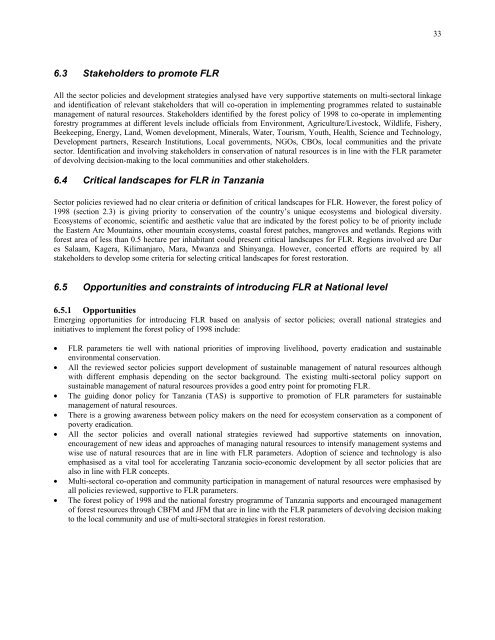FOREST LANDSCAPE RESTORATION - UNEP World Conservation ...
FOREST LANDSCAPE RESTORATION - UNEP World Conservation ...
FOREST LANDSCAPE RESTORATION - UNEP World Conservation ...
You also want an ePaper? Increase the reach of your titles
YUMPU automatically turns print PDFs into web optimized ePapers that Google loves.
33<br />
6.3 Stakeholders to promote FLR<br />
All the sector policies and development strategies analysed have very supportive statements on multi-sectoral linkage<br />
and identification of relevant stakeholders that will co-operation in implementing programmes related to sustainable<br />
management of natural resources. Stakeholders identified by the forest policy of 1998 to co-operate in implementing<br />
forestry programmes at different levels include officials from Environment, Agriculture/Livestock, Wildlife, Fishery,<br />
Beekeeping, Energy, Land, Women development, Minerals, Water, Tourism, Youth, Health, Science and Technology,<br />
Development partners, Research Institutions, Local governments, NGOs, CBOs, local communities and the private<br />
sector. Identification and involving stakeholders in conservation of natural resources is in line with the FLR parameter<br />
of devolving decision-making to the local communities and other stakeholders.<br />
6.4 Critical landscapes for FLR in Tanzania<br />
Sector policies reviewed had no clear criteria or definition of critical landscapes for FLR. However, the forest policy of<br />
1998 (section 2.3) is giving priority to conservation of the country’s unique ecosystems and biological diversity.<br />
Ecosystems of economic, scientific and aesthetic value that are indicated by the forest policy to be of priority include<br />
the Eastern Arc Mountains, other mountain ecosystems, coastal forest patches, mangroves and wetlands. Regions with<br />
forest area of less than 0.5 hectare per inhabitant could present critical landscapes for FLR. Regions involved are Dar<br />
es Salaam, Kagera, Kilimanjaro, Mara, Mwanza and Shinyanga. However, concerted efforts are required by all<br />
stakeholders to develop some criteria for selecting critical landscapes for forest restoration.<br />
6.5 Opportunities and constraints of introducing FLR at National level<br />
6.5.1 Opportunities<br />
Emerging opportunities for introducing FLR based on analysis of sector policies; overall national strategies and<br />
initiatives to implement the forest policy of 1998 include:<br />
• FLR parameters tie well with national priorities of improving livelihood, poverty eradication and sustainable<br />
environmental conservation.<br />
• All the reviewed sector policies support development of sustainable management of natural resources although<br />
with different emphasis depending on the sector background. The existing multi-sectoral policy support on<br />
sustainable management of natural resources provides a good entry point for promoting FLR.<br />
• The guiding donor policy for Tanzania (TAS) is supportive to promotion of FLR parameters for sustainable<br />
management of natural resources.<br />
• There is a growing awareness between policy makers on the need for ecosystem conservation as a component of<br />
poverty eradication.<br />
• All the sector policies and overall national strategies reviewed had supportive statements on innovation,<br />
encouragement of new ideas and approaches of managing natural resources to intensify management systems and<br />
wise use of natural resources that are in line with FLR parameters. Adoption of science and technology is also<br />
emphasised as a vital tool for accelerating Tanzania socio-economic development by all sector policies that are<br />
also in line with FLR concepts.<br />
• Multi-sectoral co-operation and community participation in management of natural resources were emphasised by<br />
all policies reviewed, supportive to FLR parameters.<br />
• The forest policy of 1998 and the national forestry programme of Tanzania supports and encouraged management<br />
of forest resources through CBFM and JFM that are in line with the FLR parameters of devolving decision making<br />
to the local community and use of multi-sectoral strategies in forest restoration.
















